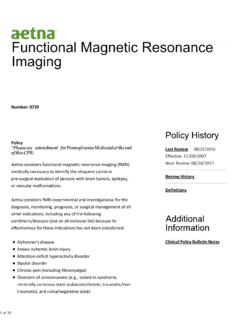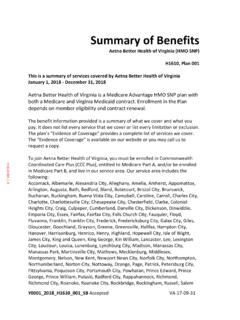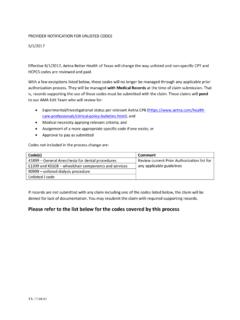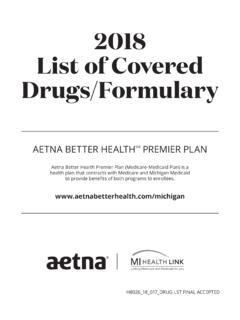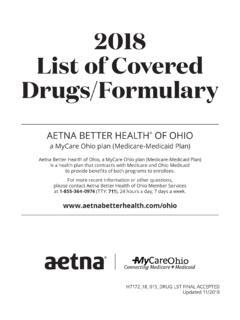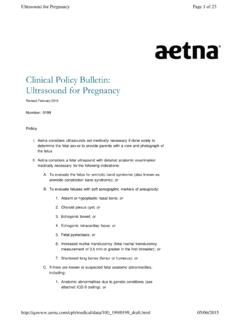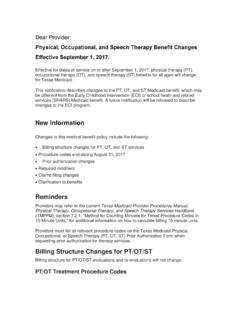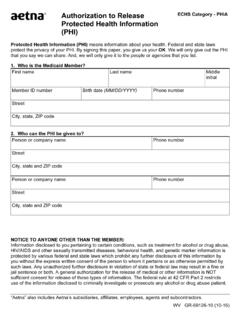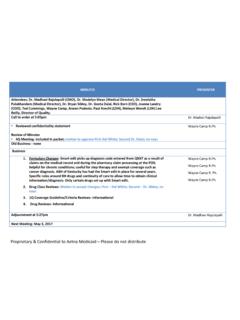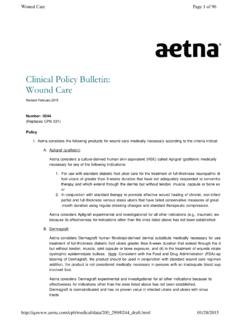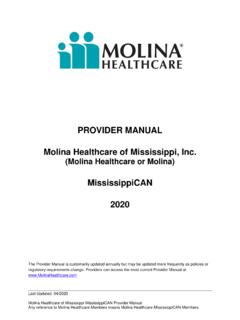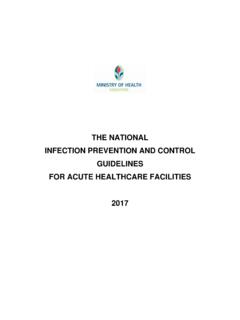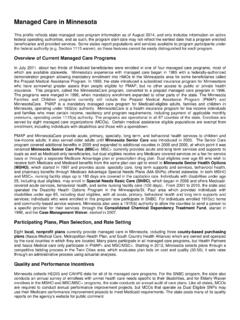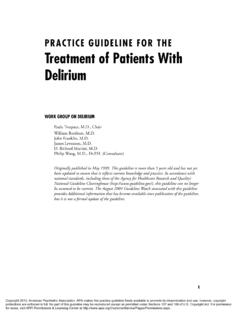Transcription of 2019 HEDIS Billing Guide and Tips - aetnabetterhealth.com
1 Gaps in Care Technical Specifications and PCP. Billing Guide HEDIS 2019. Working together to enhance the Quality of Care provided to our Members Table of Contents Disclaimer/What is HEDIS . Annual HEDIS Timeline Tips and Best Practice/HIPAA. The Importance of Documentation Quality Measures AAP - Avoidance of Antibiotic Treatment in Adults with Acute Bronchitis AAP - Adults'Access to Preventive/Ambulatory Health Services ABA - Adult BMI Assessment ADD - Follow-Up Care for Children Prescribed ADHD Medication ADV - Annual Dental Visit AMM - Antidepressant Medication Management AMR - Asthma Medication Ratio ART - Disease-Modifying Anti-Rheumatic Drug Therapy for Rheumatoid Arthritis AWC - Adolescent Well-Care Visits BCS - Breast Cancer Screening CAP - Children and Adolescents' Access to Primary Care Practitioners CBP - Controlling High Blood Pressure CCS - Cervical Cancer Screening CDC - Comprehensive Diabetes Care CDC BP - Blood Pressure Less Than 140/90 CDC DRE - Dilated Retinal Eye Exam CDC HcA1c - HbA1c testing and resuts CDC Neph - Medical Attention for Nephropathy CHL - Chlamydia Screening in Women CIS - Childhood Immunization Status COA - Care for Older Adults COL - Colorectal Cancer
2 Screening CWP - Appropriate Testing for Children with Pharyngitis DAE - Use of High-Risk Medications in the Elderly DDE - Potentially Harmful Drug-Disease Interactions in the Elderly FUH - Follow-up After Hospitalization for Mental Illness IMA - Immunizations for Adolescents LBP - Use if Imaging Studies for Low Back Pain LSC - Lead Screening in Children MMA - Medication Management for People with Asthma OMW - Osteoporosis Management in Women Who Had a Fracture PBH - Persistence of Beta-Blocker Treatment After a Heart Attack PCE - Pharmacotherapy Management of COPD Exacerbation PPC - Prenatal and Postpartum Care PSA - Non-Recommended PSA-Based Screening in Older Men SAA - Adherence to Antipsychotic Medications for Individuals with Schizophrenia SPC - Statin Therapy for Patients with Cardiovascular Disease SPD - Statin Therapy for Patients with Diabetes SSD - Diabetes Screening for People with Schizophrenia or Bipolar Disorder Who Are Using Antipsychotic URI - Appropriate Treatment for Children with Upper Respiratory Infection W15 - Well-Child Visits in the First 15 Months of Life W34 - Well-Child Visits in the Third, Fourth, Fifth & Sixth Year of Life WCC - Weight Assessment & Counseling for Nutrition & Physical Activity for Children and Adolescents Disclaimer This material serves as a tool to assist providers, their clinical team, and Billing staff with information to improve HEDIS performance.
3 HEDIS 2019 Volume 2 Technical Specifications for Health Plans was used to generate this Provider Billing Guide . The Technical Specifications were current at the time of publication (November 2018). HEDIS indicators have been designed by NCQA to standardize performance measurement and do not necessarily represent the ideal standard of care. ICD-9 codes have been removed from this Guide . For measures with a look back period further than Oct. 2016, the ICD-9 codes used with claims during that time frame will continue to be pulled into the HEDIS software. Information contained in this report is based on claims data only. What is HEDIS ? HEDIS is a registered trademark of the National Quality Committee for Quality Assurance (NCQA). Healthcare Effectiveness Data and Information Set ( HEDIS ). NCQA defines HEDIS as a set of standardized performance measures designed to ensure that purchasers and consumers have the information they need to reliably compare the performance of health care plans.
4 HEDIS is a registered trademark of the National Committee for Quality Assurance HEDIS is a performance measurement tool that is coordinated and administered by NCQA and used by the Centers for Medicare & Medicaid Services (CMS) for monitoring the performance of managed care organizations Results from HEDIS data collection serve as measurements for quality improvement processes, educational initiatives, and preventive care programs All managed care companies who are NCQA accredited perform HEDIS reviews the same time each year HEDIS 2019 consists of 92 measures across six domains of care that address important health issues HEDIS is a retrospective review of services and performance of care from the prior calendar year There are two types of HEDIS data reffered to in this Guide : Administrative data comes from submitted claims and encounters Hybrid data comes from chart collection/review Annual HEDIS Timeline Feb - Early May Quality department staff collect and review HEDIS data (on-site provider office chart collecting occurs).
5 June HEDIS results are certified and reported to NCQA. Remember that HEDIS is a retrospective process HEDIS 2019 = Calendar Year October 2018 Data NCQA releases Quality Compass results nationwide for Medicaid HEDIS Medical Record Review Process: Data collection methods include: fax, mail, onsite visits for larger requests, and remote electronic medical record (EMR) system access if available Medical record fax requests will include a member list identifying their assigned measure (s) and the minimum necessary information needed sent to the health plan Due to the shortened data collection timeframe, a turnaround time of 3-5 days is appreciated For on-site chart collections, the office will be contacted to schedule a time the abstractor can come to the office for chart review. A list of members charts being reviewed will be provided ahead of time Tips and Best Practices General tips and information that can be applied to most HEDIS measures: 1. Use your member roster to contact patients who are due for an exam or are new to your practice 2.
6 Take advantage of this Guide , coding information, and the on-line resources that can assist the practice with HEDIS measure understanding, compliance, and requirements 3. Use your Gaps in Care member list to outreach to patients in need of services/procedures. 4. You can provide evidence of completed HEDIS services and attach the supporting chart documentation by contacting the Quality Management department. 5. Schedule the members' next well-visit at the end of the current appointment 6. Assign a staff member at the office knowledgeable about HEDIS to perform internal reviews and serve as a point of contact with plans and their respective Quality Management staff. 7. Set up your Electronic Health Records (EHRs) so that the HEDIS alerts and flags to alert office personnel of patients in need of HEDIS services. HIPAA. Under the Health Information Portability and Accountability Act (HIPAA) Privacy Rule, data collection for HEDIS is permitted, and the release of this information requires no special patient consent or authorization.
7 Please be assured our members' personal health information is maintained in accordance with all federal and state laws. HEDIS results are reported collectively without individual identifiers or outcomes. All of the health plans' contracted providers' records are protected by these laws. 1. HEDIS data collection and release of information is permitted under HIPAA since the disclosure is part of quality assessment and improvement activities 2. The records you provide us during this process helps us to validate the quality of care our members received Importance of Documentation Principles of the medical record and proper documentation: 1. Enable physician and other healthcare professionals to evaluate a patient's healthcare needs and assess the efficacy of the treatment plan 2. Serves as the legal document to verify the care rendered and date of service 3. Ensure date of care rendered is present and all documents are legible 4. Serves as communication tool among providers and other healthcare professionals involved in the patient's care for improved continuity of care 5.
8 Facilitates timely claim adjudication and payment 7. Appropriately documented medical record can reduce many of the hassles'. associated with claims processing and HEDIS chart requests 8. ICD-10 and CPT codes reported on Billing statements should be supported by the documentation in the medical record Common reasons members with PCP visits continue to need recommended services/procedures: 1. Missing or lack of all required documentation components 2. Service provided without claim/encounter data submitted 3. Lack of referral to obtain the recommended service ( diabetic member eye exam to check for retinopathy). 4. Service provided but outside of the required time frame or anchor date ( Lead screening performed after age 2). 5. Incomplete services ( documentation of anticipatory guidnace during a well visit for the adolescent well child measure ). 6. Failure to document or code exclusion criteria for a measure Look for the Common Chart Deficiencies and Tips' sections for guidance with some of the more challenging HEDIS measures AAB Avoidance of Antibiotic Treatment in Adults With Acute Bronchitis measure Definition: The percentage of adults 18 64 years of age with a diagnosis of acute bronchitis who were not dispensed an antibiotic prescription.
9 *Inverted measure : Numerator identifies members prescribed an antibiotic;. considered non-compliant for the intent of this measure . Billing Reference Description ICD-10 CM. Acute Bronchitis measure Exclusion Criteria: The member is excluded from the measure if he/she has a diagnosis of pharyngitis or another competing diagnosis 30 days prior to or 7 days after the acute bronchitis diagnosis. The list of competing diagnosis includes all types of infections that would require treatment with an antibiotic. Any member with a comorbid condition diagnosis in the 12 months prior to the acute bronchitis diagnosis would be excluded. The comorbid diagnoses for this measure include: HIV, malignant neoplasms, emphysema, COPD, cystic fibrosis, tuberculosis, and other lung diseases. HEDIS stands for Healthcare Effectiveness Data and Information Set and is a registered trademark of the National Committee for Quality Assurance (NCQA). AAP Adults' Access to Preventive/Ambulatory Health Services measure Definition: Members 20 year and older who had an ambulatory or preventive care visit during the measurement year.
10 Common Chart Deficiencies and Tips: 1. Each adult Medicaid or Medicare member should have a routine outpatient visit annually. your Gaps in Care report to outreach members that have not had a visit. Billing Reference Description CPT. 99201-99205, 99211-99215, 99241-99245, 99341-99345, 99347-99350, 99381- 99387, 99391-99397, 99401-99404, 99411-99412, 99429. HCPCS UBREV. Ambulatory Visits G0402, G0438, G0439, G0463, T1015 051X, 052X, 0982, 0983. ICD 10. , , , , , , , , , , , , , , CPT. Other 92002, 92004, 92012, 92014, 99304-99310, 99315, 99316, 99318, 99324-99328, Ambulatory 99334-99337. Visits UBREV 0524, 0525. Any of the above ambulatory visits with or without a telehealth modifier: Telehealth CPT Modifier: 95, GT. Online CPT 98969, 99444. Assessments Telephone CPT 98966-98968, 99441-99443. Visits HEDIS stands for Healthcare Effectiveness Data and Information Set and is a registered trademark of the National Committee for Quality Assurance (NCQA). ABA Adult BMI Assessment measure Definition: The percentage of members 18 74 years of age who had an outpatient visit and whose body mass index (BMI) was documented in 2017 or 2018.
